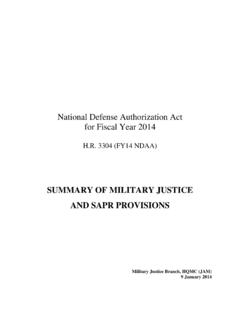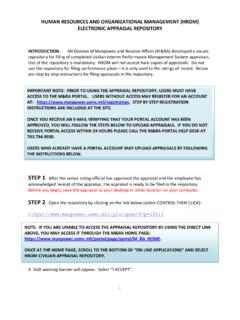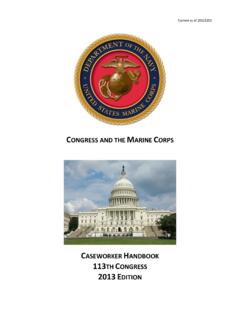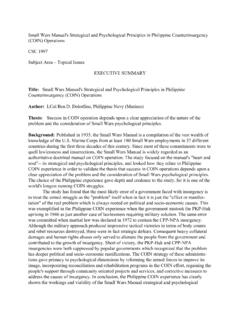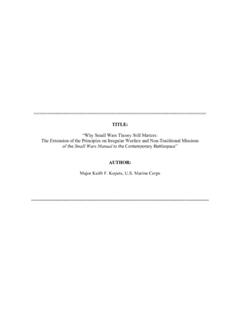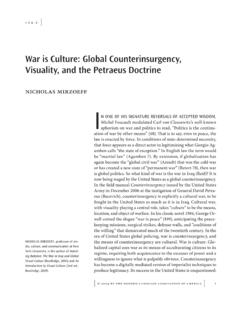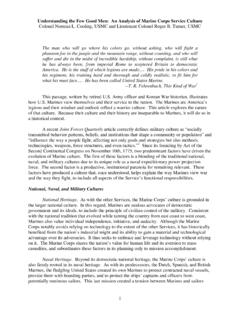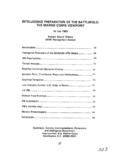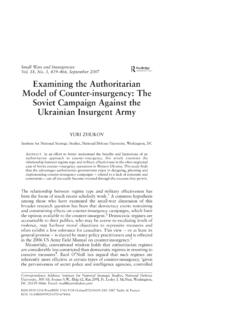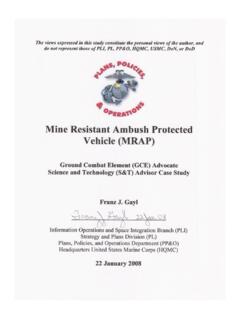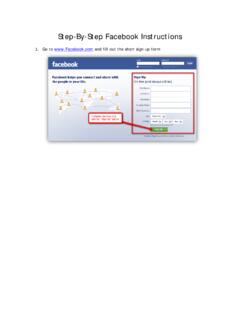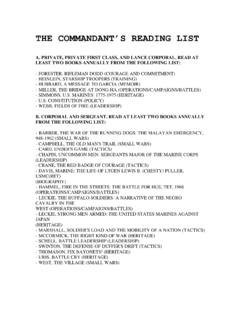Transcription of Forward Deployed and Forward Engaged: The Marine Corps ...
1 Forward Deployed and Forward Engaged: The Marine Corps Approach to 21st Century Security CooperationiForward Deployed and Forward Engaged: The Marine Corps Approach to 21st Century Security CooperationAs America s Expeditionary Force in Readiness, the Marine Corps must be ready to respond to today s crisis, with today s In order to be postured as the nation s crisis response force, we require continual engagement with ally and partner militaries around the globe. This pamphlet articulates the Marine Corps approach to security cooperation, how we support combatant commander theater campaign plans, and the international programs in place to help develop the Marine Corps as an integral part of the future Joint are Forward Deployed and Forward engaged around the world. We work with foreign military partners to coordinate and prepare for operations, enhance interoperability, build or maintain partner capacity, and adopt best practices on topics ranging from doctrine development to research and development.
2 In a twenty-first century operating environment that requires international partnerships, our efforts are paying off. As a result of a significant security force assistance initiative our coalition partners from the Republic of Georgia have sent a series of battalions to southern Afghanistan without national caveats. We are also at the center of a renewed focus on the Pacific Marines have arrived in Darwin, the current emphasis on security cooperation has a new strategic rationale, many generations of Marines have been engaged with international partners, both in times of stability and war. Our relatively small size and warrior ethos has made us an attractive partner on the global stage. Looking to the future, we will continue to develop amphibious forces that are not only fighters, but who can also serve as trainers, mentors and advisors. Our commitment to security cooperation is steadfast Marines will be Forward Deployed and Forward engaged, partnering in peacetime to help the nation avoid war, but prevailing together with our partners when disaster strikes or conflict Fidelis,R.
3 T. Tryon Lieutenant General, Marine Corps Deputy Commandant for Plans, Policies & Operations (PP&O)iiiiiForward Deployed and Forward Engaged: The Marine Corps Approach to 21st Century Security CooperationTABLE OF CONTENTSP urpose ..1 Background ..1 Our .Heritage .. 3 Fulfilling .Our .Title .10 .Responsibilities .. 5 Force Constructs .. 5 Key Programs and Initiatives .. 7 Conclusion ..9 Appendix .A: . Marine . Corps .Security .Cooperation .in .2011 ..10 Appendix .B: . Marine . Corps .Security .Cooperation .Organizations ..11iv1 PURPOSEThe purpose of this document is to provide an overview of the Marine Corps approach to security cooperation and the state of our related activities and programs. The Marine Corps commitment to security cooperation is steadfast, rooted in the need to limit involvement in conflict while being postured to respond when necessary, strengthened by our legacy of working with foreign militaries, and enabled by an institutional investment in training and educating Marines who are not only fighters, but also trainers, mentors, and approach highlighted in this document is derived from the priorities articulated in the Commandant s Planning Guidance and the January 2012 Defense Strategic America s Expeditionary Force in Readiness, the Marine Corps is Forward Deployed and Forward engaged: shaping.
4 Training, .deterring, .and .responding to all manner of crises and contingencies. Each of these roles requires sustained cooperation with our international partners. We are shaping through engagement activities that seek to improve the capacity of partner governments and their security forces, The Marine Corps is America s Expeditionary Force in Readiness a balanced air-ground-logistics team. We are Forward - Deployed and Forward -engaged: shaping, training, deterring, and responding to all manner of crises and contingencies. General James F. Amos Commandant of the Marine CorpsForward Deployed and Forward Engaged: The Marine Corps Approach to 21st Century Security CooperationCMC .Priorities:1. Continue to provide the best trained and equipped Marine units to Afghanistan. This will not change. This remains our top priority! Provide the best trained teams for conducting Security Force Assistance with Afghan security forces.
5 Continue to train, advise, and augment coalition partners that operate alongside Marines in Rebalance our Corps , posture it for the future and aggressively experiment with and implement new capabilities and organizations. Provide innovative, rotational solutions to meet theater security cooperation (TSC) requirements in support of geographic combatant commanders (GCC).3. Better educate and train our Marines to succeed in distributed operations and increasingly complex environments. Resource security cooperation organizations in order to maintain adviser skills, training, and assessment expertise focused on building partnership Keep faith with our Marines, our Sailors and our situations from degrading to a point where they threaten our national interests. We are training with our partners to increase interoperability in order to be better prepared to deal with crises.
6 We are deterring through a persistent naval presence that is amplified by coordination with allies. Finally, we are prepared for responding to crises or contingencies by advising or operating alongside our coalition brethren. Each of these roles directly relates to what the Department of Defense (DoD) refers to as security cooperation. The mission set of security cooperation demands Marines who are not only fighters, but also trainers, mentors and advisors roles requiring unique and highly-desirable have answered the National Security Strategy s emphasis on security cooperation and will continue to provide trained, organized, and equipped Marines to fulfill combatant commander engagement requirements. Task-organized, trained, and augmented for missions across the globe, our forces active and reserve focus on two major aspects of security cooperation: interoperability with higher-end allies and security force assistance with developing partners.
7 The commonality between these two missions is that relationships are the key. Thus we invest heavily in the training and education that allows Marines to build trust and cooperation around the Marine Corps provides a unique contribution to DoD s collective security cooperation activities. Due to our relatively modest size and legacy of working with international partners, many foreign militaries view the Marine Corps as their partner of choice. As part of the Joint Force, the Marine Corps and Navy work together to leverage the significant advantages that amphibious forces provide a maritime power like the United States sea basing provides access while maintaining a diplomatically sensitive profile, and allows us to work with the increasing number of partner militaries that are investing in amphibious capabilities. Finally, as we conduct our security cooperation activities, we never lose sight of our role as America s Expeditionary Force in Readiness, always ready to respond to crises, be they natural or man-made.
8 When Marines are trained to conduct security cooperation, they are also ready to provide humanitarian assistance or prevail in conflict when the need we look to the future, we see a world in which security cooperation plays an increasingly important role in Marines from the Marine Corps Security Cooperation Group preparing Georgians for deployment to southern AfghanistanMany generations of Marines have been engaging with international partners, in peacetime and wartime, to build interoperability and partner nation s strategic landscape. But it is also important to realize that we have been conducting security cooperation throughout the existence of the Marine Corps . In many ways, security cooperation is what we excel at: partnering in peacetime to help the nation avoid war, but prevailing together with our partners when disaster strikes or conflict .HERITAGEA lthough the current emphasis on security cooperation has a new strategic rationale, many generations of Marines have been engaging with international partners, in peacetime and wartime, to build interoperability and partner capacity.
9 Sailors and Marines have participated in large-scale, multinational naval exercises for over half a century. As the longest running multilateral maritime training exercise in the world, UNITAS (Latin for unity ) has been a premier military engagement tool in support of foreign policy in the Western Hemisphere since 1959. This annual multi-month exercise brings together militaries in the region to build confidence between historically suspicious neighbors, enable global peacekeeping operations, increase interoperability between and partner naval forces, and positively influence military cultures throughout the continent. Through multinational naval exercises like UNITAS, the Navy- Marine Corps team provides Geographic Combatant Commanders (GCC) with significant contributions to their theater campaign and Now: Combined Action Program in 1966 (Left) and Southern Partnership Station in 2011 (Right)The Marine Corps provides a unique contribution to DoD s collective security cooperation activities: Viewed as a partner of choice for foreign security forces Utilize the advantages of sea-basing Able to rapidly adapt from engagement to crisis response Postured in the Pacific4 Another part of our legacy in security cooperation is combat advising and building partner capacity during counterinsurgency efforts.
10 Long before Iraq and Afghanistan, Marines played a central role in counterinsurgency efforts in places as near as Haiti and distant as Vietnam. By organizing, training, equipping, advising, and operating with a Haitian constabulary force in the early 1930s, the Marine Corps provided political leaders with an opportunity to responsibly end a tough occupation. Haiti and a host of other operations in the pre-World War I and interwar periods led to the development of the small wars manual in 1940, which is still used by the Marine Corps and militaries worldwide as a primary training document. In Vietnam, our Combined Action Platoon (CAP) program was arguably the most innovative and successful aspect of the war. Marine squads teamed with village soldiers to gradually pacify swaths of territory by protecting vulnerable populations and building the capacity and capability of local defense forces.



